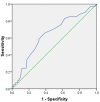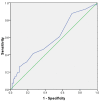Prediction of mortality in hip fracture patients: role of routine blood tests
- PMID: 25692170
- PMCID: PMC4322126
Prediction of mortality in hip fracture patients: role of routine blood tests
Abstract
Background: To assess the mortality predictive value of routine blood tests in patients with hip fracture.
Methods: In a retrospective descriptive study, medical records of 204 hip fractured patients with the age of 60 or older who were admitted to the Department of Orthopedics was considered regarding routine laboratory tests. Predictive values of these tests were assessed using receiver operating characteristic curve (ROC).
Results: The incidence of death due to hip fracture was 24%. The mortality rate was significantly increased with age > 65 (OR= 15). There was no significant difference between mortality in regards to gender. High plasma BUN (more than 20 mg/dl) and creatinine (more than 1.3 mg/dl) significantly increased the chance of mortality. [OR= 3.0 and OR=2.5 for BUN and creatinine, respectively]. Patients' mortality did not show any correlation with sodium and potassium plasma levels and blood hemoglobin.
Conclusions: There is direct correlation between plasma levels of BUN and creatinine and 3-month mortality after hip fractures. Patients with high plasma levels of BUN were three times more likely to die than those with normal BUN. Also, patients with high plasma creatinine levels were 2.5 times more likely to die than those who had normal values. Mortality was also associated with increasing age but did not vary with gender. Patients aging more than 65 were 15 times more likely to die following a hip fracture than those with younger age.
Keywords: BUN; Creatinine; Hematologic tests; Hip fracture; Prognosis; Serologic tests.
Figures
References
-
- Laulund AS, Lauritzen JB, Duus BR, Mosfeldt M, Jorgensen HL. Routine blood tests as predictors of mortality in hip fracture patients. Injury. 2012;43(7):1014–20. - PubMed
-
- National Hospital Discharge Survey (NHDS), National Center for Health Statistics. Available at: http://205.207.175.93/hdi/ReportFolders/ ReportFolders.aspx?IF_ActivePat... . [Accessed August 29, 2013].
-
- Scott JC. Osteoporosis and hip fractures. Rheum Dis Clin North Am. 1990;16(3):717–40. - PubMed
-
- Nguyen ND, Eisman JA, Center JR, Nguyen TV. Risk factors for fracture in nonosteoporotic men and women. J Clin Endocrinol Metab. 2007;92:955–62. - PubMed
LinkOut - more resources
Full Text Sources


